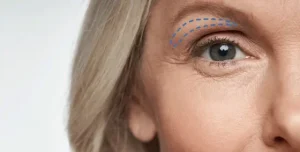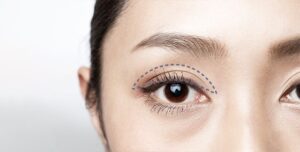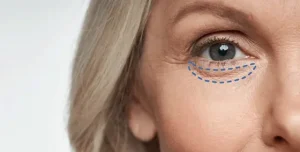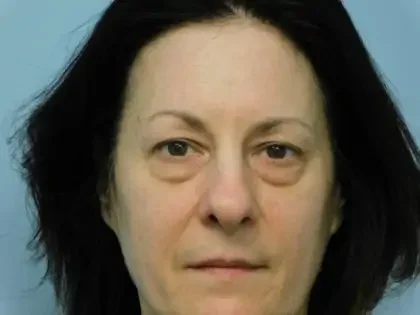Blepharoplasty (Eyelid Surgery)
The earliest signs of aging can often appear in the eyelid region, as the delicate skin around the eyes becomes thinner and loses elasticity. Symptoms such as sagging upper eyelids and pronounced lower-lid fat pads (also known as under-eye bags) can produce a tired or fatigued appearance even if the individual is not actually feeling that way. Unfortunately, at-home treatments are usually ineffective for improving these cosmetic concerns, especially for moderate to severe cases. However, eyelid surgery can restore a vibrant, rejuvenated appearance by removing excess skin, muscle, and fat around the eyes and dramatically boost self-confidence for both women and men across the age spectrum.
Dr. Jonathan Pontell has decades of experience in facial plastic surgery and has performed over 4,000 eyelid surgeries. Dr. Catherine Weng has 9 years of experience and is also extensively skilled with both upper and lower eyelid surgery. In fact, both Dr. Pontell and Dr. Weng are board-certified in both facial plastic surgery and otolaryngology (head and neck surgery), enabling them to provide expert-level care using the latest surgical advancements in state-of-the-art facilities. One of our facial plastic surgeons can create a customized treatment plan designed to refresh and rejuvenate the area around the eyes with results that look natural.
Topics On This Page:
What Is Blepharoplasty?
Blepharoplasty is the medical term for eyelid surgery, which is a procedure designed to create a more youthful and refreshed appearance around the upper and/or lower eyelids. Eyelid surgery can correct excess, sagging skin, fine lines, wrinkles, hollows, puffiness, and under-eye bags by removing or repositioning excess tissue and fat and lifting and tightening the skin in the area. In some cases, eyelid surgery can address severely drooping upper eyelid skin that may be obstructing the patient’s peripheral vision.

What Are the Benefits of Eyelid Surgery?
Blepharoplasty offers many potential benefits to patients by improving the form and function of the eyelids, including:
- Reducing Fine Lines and Wrinkles – By tightening and removing excess fat, muscle, and skin surrounding the eyes, blepharoplasty helps to diminish the visibility of fine lines and wrinkles and can provide smoother, firmer eye contours.
- Creating a Younger, More Alert Appearance – With the elimination of displaced fat, excess skin, and sagging muscles that can contribute to a tired, saddened, or prematurely aged appearance, patients can anticipate a more revitalized and youthful look, characterized by eyes that appear alert and rejuvenated.
- Improving an Obstructed Visual Field – When excessive skin or drooping tissues on the upper eyelids obstruct the pupil, functional eyelift surgery can effectively resolve the issue by lifting and tightening the area to correct impaired peripheral vision.
During a consultation, Dr. Pontell or Dr. Weng will assess your cosmetic concerns to determine whether eyelid surgery will be the most advantageous option to achieve your aesthetic goals.
Am I a Good Candidate for Blepharoplasty?
Ideal candidates for eyelid surgery are typically individuals with excess sagging skin in the upper and/or lower eyelids that cause fine lines and wrinkles, fatty deposits that make the eyelids appear puffy, prominent under-eye bags, and eyelids that droop to the point of showing white below the iris. In general, upper eyelid skin sagging may develop for some individuals in their 30’s but others may not see this aging process until they reach their 50’s.
Patients should be non-smokers (as smoking and vaping are bad for optimal healing), in good overall health without eye conditions that may interfere with the recovery process, and have realistic expectations to ensure optimal blepharoplasty results. Depending on your aesthetic concerns and facial anatomy, our surgeons may recommend combining a brow lift or facelift with blepharoplasty for a more comprehensive facial rejuvenation.
Personal Consultation
 The initial consultation with Dr. Pontell or Dr. Weng provides the opportunity for you to learn more about the blepharoplasty procedure and for our surgeon to evaluate your facial structure and discuss your cosmetic concerns and goals. They will examine and take photographs of the anatomy and structures of your eyelids, eyebrows, and forehead to determine the most appropriate surgical technique and treatment plan. Our surgeon will also review your medical history and discuss any potential risks associated with the procedure. During this time, you are encouraged to ask questions that will help guide you in your decision and we will do everything we can to ensure you feel comfortable and supported throughout the process. Once the consultation is complete, you will receive your recommended treatment plan and cost estimate, with information regarding the next steps for how to proceed with scheduling surgery.
The initial consultation with Dr. Pontell or Dr. Weng provides the opportunity for you to learn more about the blepharoplasty procedure and for our surgeon to evaluate your facial structure and discuss your cosmetic concerns and goals. They will examine and take photographs of the anatomy and structures of your eyelids, eyebrows, and forehead to determine the most appropriate surgical technique and treatment plan. Our surgeon will also review your medical history and discuss any potential risks associated with the procedure. During this time, you are encouraged to ask questions that will help guide you in your decision and we will do everything we can to ensure you feel comfortable and supported throughout the process. Once the consultation is complete, you will receive your recommended treatment plan and cost estimate, with information regarding the next steps for how to proceed with scheduling surgery.
What Does the Blepharoplasty Procedure Involve?
Blepharoplasty surgery is typically performed under local anesthesia, IV sedation, or general anesthesia, depending on your comfort level and desired level of awareness. Eyelid surgery is an outpatient procedure that takes approximately one to two hours to complete.
Upper Blepharoplasty
 The surgeon starts by marking the eyelid after testing how much tissue can be safely removed to achieve optimal results. Next, an incision is made within the natural fold of the upper eyelid, and an ellipse of skin is removed from the deep part of the upper lid crease. Some patients may also benefit from extracting a portion of the muscle that is deep within the upper eyelid skin. After the resection is through, the eyelid is carefully sutured across the natural crease, so the scar remains easily concealable.1
The surgeon starts by marking the eyelid after testing how much tissue can be safely removed to achieve optimal results. Next, an incision is made within the natural fold of the upper eyelid, and an ellipse of skin is removed from the deep part of the upper lid crease. Some patients may also benefit from extracting a portion of the muscle that is deep within the upper eyelid skin. After the resection is through, the eyelid is carefully sutured across the natural crease, so the scar remains easily concealable.1
Asian Eyelid Surgery
 Some individuals are born without an upper eyelid crease, which is sometimes referred to as single eyelid. A similar procedure can be performed to create a permanent upper eyelid crease where there was none before. This is sometimes called Double Eyelid surgery. This is done with a similar incision to the upper blepharoplasty and specially placed sutures are used to create a permanent eyelid crease.
Some individuals are born without an upper eyelid crease, which is sometimes referred to as single eyelid. A similar procedure can be performed to create a permanent upper eyelid crease where there was none before. This is sometimes called Double Eyelid surgery. This is done with a similar incision to the upper blepharoplasty and specially placed sutures are used to create a permanent eyelid crease.
Lower Blepharoplasty
 To begin, our doctor will mark out the area beneath the eyes that produces the appearance of under-eye bags. Once the amount of fatty tissue, skin, and muscle to be removed is determined, our surgeon typically uses a local anesthetic to numb the area, then carefully makes the incisions. When excess skin also needs to be removed from the lower eyelid, a small incision is made just under the lower eyelashes. Fat and sagging skin are removed through the incisions, and muscles may be lifted or tightened to provide more flattering eyelid contours. If the lower eyelid muscle needs to be lifted, the procedure is known as a Skin Muscle Flap.
To begin, our doctor will mark out the area beneath the eyes that produces the appearance of under-eye bags. Once the amount of fatty tissue, skin, and muscle to be removed is determined, our surgeon typically uses a local anesthetic to numb the area, then carefully makes the incisions. When excess skin also needs to be removed from the lower eyelid, a small incision is made just under the lower eyelashes. Fat and sagging skin are removed through the incisions, and muscles may be lifted or tightened to provide more flattering eyelid contours. If the lower eyelid muscle needs to be lifted, the procedure is known as a Skin Muscle Flap.
Some patients only need an internal lower eyelid incision (transconjunctival); however, others may require an external incision also. If an external incision is necessary, the lower eyelid is sutured with a running stitch.2
In other cases, fat that is unnecessary and causing bags or drooping in one area can be repositioned in another area of hollowing and secured with stitches and temporary bolstering. This can restore the ideal lower lid and cheek contour that plastic surgeons and the aesthetic community refer to as the ogee curve.
Awake Surgery for Blepharoplasty
For many patients, upper and lower eyelid surgeries are among several procedures that may be performed comfortably while awake with the use of local anesthesia and mild oral sedation. With faster recovery and reduced risks, awake surgery offers an appealing option for the right patient.
Blepharoplasty Timeline
Prior to surgery, you will be given detailed information and instructions for what to expect before, during, and after surgery and throughout the recovery process. In general, eyelid surgery patients can anticipate:
Before Surgery:
Do not take aspirin, ibuprofen, fish oil, and most supplements for two weeks before surgery. Get a good night’s sleep and do not eat or drink anything after midnight the night before surgery if you are having sedation or general anesthesia.
Immediate Post-Op:
Wake up in the recovery room. Usually after 45 minutes to 1 hour, you will be discharged and your family member or friend can drive you home. If your surgery was done under local anesthesia, your friend or family member can take you home immediately after surgery.
1st Day At Home:
You may have swelling and bruising around your eyes. You should be applying cold compresses with iced saline as much as possible for the first two days after surgery.
2nd Day:
Swelling may increase, it may be difficult to open your eyes when the lids are swollen. Continue using cold compresses.
1 Week:
Stitches are removed. Your visual acuity may be a little off initially after surgery, which will resolve quickly.
2 Weeks:
Swelling and bruising fades. You can cover incisions with makeup. You should use sunscreen and wear sunglasses anytime you are outside.
6 Weeks:
The swelling and bruising has decreased significantly and you will typically have a good idea of what the result will be. Continue to protect incisions from sun exposure for one year.
What Can I Expect During Recovery from Eyelid Surgery?
After your procedure, our surgeon will provide you with instructions on how to care for your surgical wounds properly. You should use iced saline gauze pads and ointments to help ease swelling and discomfort. Patients will typically experience some minor discomfort from surgery; however, any pain can be alleviated with medication prescribed by Dr. Pontell or Dr. Weng.
Expect to experience swelling and bruising after your procedure. This is normal and typically resolves within two weeks. The average patient returns to work in about one week and you should be able to return to your usual activities about two weeks after your surgery.
Because incisions are hidden along the natural lines and creases of the eyes, the scars will fade over time. Scars generally are not visible once healing is complete.
What Is Revision Eyelid Surgery?
Our facial plastic surgeons have seen many patients who have undergone an eyelid lift with another doctor and were not satisfied with the final results. This may be caused by an asymmetrical outcome, problems with the height of the new crease, triple folds, and other possible complications.3 In these cases, Dr. Pontell or Dr. Weng can perform a customized revision blepharoplasty, also referred to as reconstructive eyelid surgery, to address and improve specific concerns caused by the original cosmetic eyelid procedure.
For the best results after eyelid surgery, patients must wait at least six months to one year after the initial blepharoplasty procedure. This allows the tissues time to heal fully and for the final results to become apparent.
How Much Does Eyelid Surgery Cost?
At the Aesthetic Facial Plastic Surgery Center, a blepharoplasty procedure has an average cost of between $4,500 and $8,500. The price will vary based on the extent of the treatment plan, whether the surgery will be performed on both the upper and lower eyelids, and pricing related to associated facility costs, surgeon and anesthesia fees, and other factors. Our team will be able to give you a clearer estimate and more detailed information about eyelid surgery after an initial consultation. We also offer financing options for qualified applicants through trusted third-party healthcare lenders that provide low monthly payment plans for cosmetic procedures.
Additional Frequently Asked Questions About Blepharoplasty Surgery
Will I Look Like Another Person After Eyelid Surgery?
Eyelid surgery is not intended to make you look like another person but rather to refresh and rejuvenate your current appearance. Our doctor’s eyelid surgery procedure is highly technical and precise, removing the correct amount of fat, tissue, and skin to revive your appearance while ensuring it does not look “overdone.”
Will My Eyes Look “Pulled Back” After Blepharoplasty?
Facial plastic surgery has improved over the past few decades. The most recent and modern techniques are designed to help patients achieve natural-looking results. Dr. Pontell and Dr. Weng are experienced facial plastic surgeons who offer the latest advancements in blepharoplasty. They can help you achieve results that make you appear more youthful while maintaining your unique look.
How Difficult Is Eyelid Surgery Recovery?
Recovering from blepharoplasty is relatively straightforward. During the first few days, it is common to experience mild discomfort, swelling, and bruising around the eyes. Applying cold compresses and keeping your head elevated can help minimize these symptoms. As the healing progresses, the swelling will gradually subside, revealing the final results.
How Can I Manage Pain After Eyelid Surgery?
Dr. Pontell or Dr. Weng will prescribe pain medication to help manage any discomfort during the initial stages of recovery. It is important to follow the prescribed dosage instructions and avoid any medications that may increase bleeding or interfere with the healing process.
To learn more about eyelid surgery, or to schedule a consultation with Dr. Pontell or Dr. Weng, please contact our Philadelphia office today.






